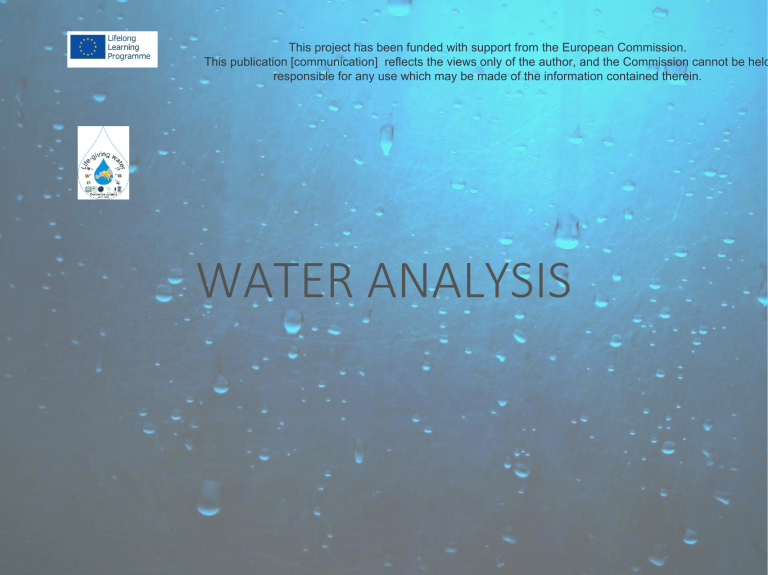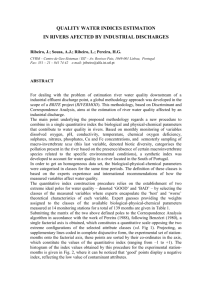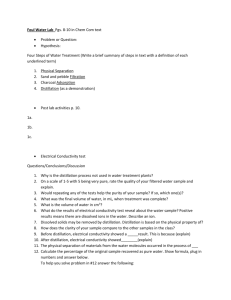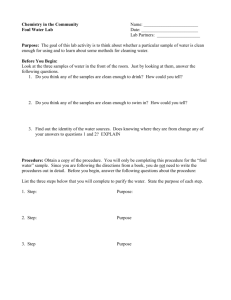Anxhelo and Christian presentation - Life

This project has been funded with support from the European Commission.
This publication [communication] reflects the views only of the author, and the Commission cannot be held responsible for any use which may be made of the information contained therein.
WATER ANALYSIS
ACID RAINS
Acid rains are rainfalls containing particles, gases and compounds as sulphuric acid
(H
2
SO
4
) and nitric acid
(HNO
3) derived also from use of fossil fuels.
• Wet:
FALLOUT OF PARTICLES
Rain Snow/Hailstorm
• Dry: Gravity
ENVIRONMENTAL DAMAGES
Rainfalls water is acidified by the presence of:
Sulphuric acid:
Nitric acid:
4 NO
2
+ O
2
+ 2 H
2
O → 4 HNO
3
(aq)
These are strong acid which give rainwater pH below 5.0
pH of unpolluted rain is acid also because carbon dioxide (CO
2
), naturally occurring in atmosphere, reacts with water to form carbonic acid, a weak acid according to the following reaction:
CO
2(g)
+ H
2
O
(l)
→ H
2
CO
3 (aq) causing a decrease of pH at values usually no lower than 5.7
Acid rain attacks buildings, steel bridges and ancient monuments, causing enormous damages to the cultural heritage of the country as well.
Nitric acid corrodes all metals and, by the time, even cement. The sulphuric acid corrodes the calcium carbonate (limestone) and transforms it into calcium sulphate (gypsum).
H
2
SO
4 (aq)
+ CaCO
3 (s)
→ CaSO
4 (s)
+ H
2
O + CO
2 (g)
CHEMICAL ANALYSIS OF WATER
Qualitative Analysis of Water is mainly based on a research of:
1. pH, that measures the degree of neutrality, basicity or acidity of an aqueous solution based on the logarithmic concentration of hydrogen ions [ H+ ]
2. Electrical conductivity
3. Anions, chlorides, sulphates, phosphates and nitrates:
A. Using the colorimetric method
B. Following the semi-micro qualitative analysis, (precipitation reactions)
pH scale:
0.1 - 0.5
1.5 - 2.5
pH check of the rainwater sample
2.9 - 4.5
5.0 - 5.5
6.5
7.45
8 9 10
7
Neutral
Acidic Alkaline
Instruments:
11.5 - 13.5
Liquid indicators Litmus test pH meter
14
ELECTRICAL CONDUCTIVITY
This analysis shows the electrical conductivity of an aqueous solution.
A solution can conduct electricity only if it contains dissolved ions.
Distilled water has no salts in it, so it is not a conductor.
Rainwater can conduct only if it contains dissolved ionic species.
To analyze the EC (Electrical
Conductivity) we use the
Conductivity-meter, a simple device with low voltage lamps. These low voltage lamps switch on as the electric current flows in.
SULPHATES FINDING (SO
4
)
The Barium chloride - BaCl
2
- with the sulphates forms a white precipitant (BaSO
4
).
SO
4 (aq)
+ Ba
(aq)
→ BaSO
4
We can also evidence the Sulphates with a colorimetric analysis
ORGANIC PHOSPHATES FINDING (PO
4
3–
)
We generally can find them in pesticides.
They usually are detected by a colorimetric analysis.
2
3Ag + 2HPO
4
→ Ag
3
PO
4
+ H
2
PO
4
NITRATES ANALYSIS
Besides colorimetric analysis the Nitrate ion can be detected by the following procedure:
Add H
2
SO
4 to 6-7 ml of watery solution until the acid reacts with the Litmus paper.
Now heat up a bit to make the CO
2 evaporate. Add 2 ml of FeSO
4.
Tip the test tube and add 5-6 ml of concentrated H
2
SO
4 without shaking it. At the top of the solution a brown ring of Penta aqua Nitrosyl Iron (II) will develop:
[Fe(NO)(H
2
O)
5
]2+
CHLORIDES FINDING (Cl )
Rainwater analysis results:
Chlorides
Nitrates
Sulphates pH
Phosphates
Yes
Yes
Yes
4.5
Yes
The pH results extremely low thanks to the acids presence.
Therefore the water resulted positive to the electrical conductivity test.
DISTILLATION
Distillation is a process used to separate the water from the dissolved salts
Simple distillation device used in chemistry labs
Layout of a simple distillation generally used by students in chemistry labs







